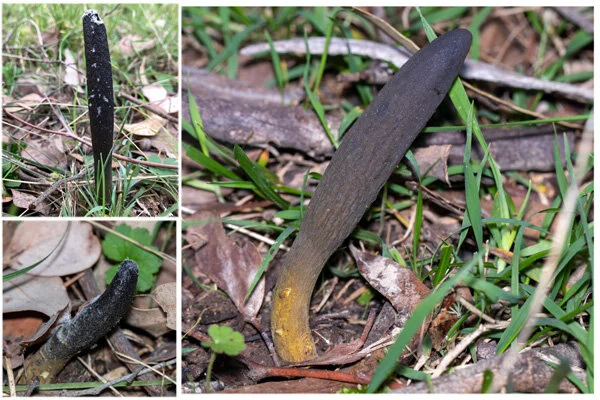The vegetable caterpillar – an intriguing fungus
/Sue spotted one first. A small grey-green column sticking out of the forest floor at Wooragee, this one about 5 centimetres tall and roughly the shape of a finger.
I shrieked with delight!
It was a Cordyceps*, a fungus that parasitises caterpillars.
While many animals eat various types of fungi, in this case the relationship is reversed, with the fungi preying on an insect.
Photo: various examples of the club fungi we saw
Maybe they don’t look fascinating to you. Or perhaps you think it looks like something from witchcraft or science fiction?
What we could see of these fungi is only part of the story. I was introduced to this fungi by Alison Pouliot and I’ve been delighted whenever I have come across them ever since.
Alison has been visiting our area each autumn for many years, conducting fungi forays and promoting awareness of this incredible kingdom. This year, her workshops switched to online delivery, but Alison is still sharing her knowledge and inspiring attendees to learn and look.
If you haven’t attended one of Alison’s workshops (often hosted by local Landcare groups, including Wooragee Landcare) put it in your calendar for next autumn.
Photo: Wooragee Landcare workshop with Alison Pouliot (in green) – fungi and photography, 2019
How can a fungus ‘catch’ a caterpillar?
The Cordyceps spores are tiny and it’s thought caterpillars ingest them while moving through the leaf litter. The spores germinate inside a caterpillar and, as Alison explains, “The resulting mycelium feeds on the caterpillar and completely fills its body cavity, effectively consuming it from inside out, killing it in the process and transforming it into a mummy.”
Having extracted the nutrients from the caterpillar, the fungus waits for the right conditions to put up a reproductive structure (stroma, sometimes referred to as the ‘fruiting body’ or club) above ground from which it releases its spores. And the cycle begins again.
Alison’s specimens show how the long white fungal tissue the extends into the soil and entirely around the mummified caterpillar.
Photo: Cordyceps display at a workshop presented by Alison Pouliot. The wriggly line represents the ground, with the ‘club’ visible above ground and the fungal stem and parasitised caterpillar extending below.
We spotted more of these clubbed fungi as we continued our meander.
Some were fresh while others were past their prime. They varied in height from around 4 cm to 8 cm and in colour from olive to black. The top of the club has tiny dots (ostioles) which is where the white spores emerge from. Apparently, the colour of the stem near the ground is determined by the species of caterpillar. The more ‘food’ the fungi obtains from the caterpillar, the larger the club. Sometimes, if the caterpillar is particularly nutritious, there can be two clubs from a single source.
The ones we saw on this visit (top photo) are the species Drechmeria gunnii. Their common name is dark vegetable caterpillar.
* It was formerly Cordyceps gunnii and collectively the broader group are still often referred to as Cordyceps.
Features contributing to their identification include shape, colour, and the smooth transition between the ‘stem’ and ‘head’ parts of the club. Other similar species can also be found in this National Park. The identification was confirmed by Tom May from the FungiMap project via iNaturalist.
The caterpillars the fungi preys upon
On a field trip during Alison’s workshops with Wooragee Landcare last year, we came across a stunning pink Oxycanus moth. It was on a rotting log, beneath wattles in private bushland not far from the fungi sightings mentioned above.
Photo: Oxycanus moth
This moth belongs to the family Hepialidae, known as swift and ghost moths. Its caterpillars are among those the fungi preys upon, along with others from this family.
The moths in this family are typically short-lived as adults. Some spend just one night in their adult form. They often emerge en masse after rain in autumn. They mate, the females lay oodles of eggs and by the morning the moths are breakfast for birds!
The caterpillars dig burrows in the ground and line them with silk. At night they come out to feed on leaves and leaf litter. Assuming they haven’t been parasitised by fungi, they pupate in their burrow and as the adults emerge they often leave their empty pupal case half sticking out of the burrow or on the ground nearby.
I’m sure you’ve seen some. They are frequently found under eucalypts and acacias in autumn or early winter. Along with the vegetable caterpillar fungi, we also spotted plenty of these cases in the same area.
A FungiMap target species
This species (and several other ‘club fungi’) are on the list of target species for the FungiMap project. Their aim is to collect records of a wide range of fungi types across Australia. You can add your sightings by sharing photos and observational notes to the project via iNaturalist.
I have and hope you will too!






